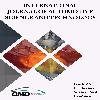An Examination of the Vibrational Characteristics of a Diesel Engine Connecting Rod Using Modal Analysis
In this study, a connecting rod that belongs to a diesel test engine is examined with an experimental method and the Finite Element Method (FEM). The purpose of the experimental method is to obtain the Frequency Response Function. The graph of this function provides the necessary vibrational qualifications of the connecting rod. Obtained vibrational characteristics can be considered as natural frequencies, damping ratios and mode shapes that belong to these vibrational modes. While natural frequencies can be obtained with both of these methods, mode shapes could only be produced with FEM. The natural frequencies that are obtained with experimental method is determined for the first mode as 0,625 Hz, for the second mode as 4,38 Hz, and for the third mode as 8,13 Hz. The natural frequencies that are obtained with FEM is determined for the first mode as 0,04575 Hz, for the second mode as 8,3861 Hz, and for the third mode as 8,9434 Hz. Considering the frequency range of the connecting rod, this study shows that the natural frequency values which is determined from this study and any frequency value of the connecting rod while the engine is running would not coincide. Besides damping ratios are calculated for the first mode as 19,766 %, for the second mode as 8,0116 %, and for the third mode as 3,4839 %. It is determined which modes have bending and torsion mode shapes. The results provide the useful information about the weaknesses and the vibrational qualifications that has to be improved in terms of dynamical and structural analysis of the connecting rod or engine itself.
Keywords:
Modal analysis Connecting rod, Frequency response function,
___
- [1] Pulkrabek WW. Engineering fundamentals of the internal combus-tion engine. Prentice Hall. 2007; 15.
- [2] Çetinkaya S. Taşıt mekaniği. Nobel Yayın Dağıtım. 2010; 23.
- [3] Grohe H. Otto ve Dizel Motorları. Bilim Teknik Yayınevi. 1999; 6, 249, 250.
- [4] https://www.uml.edu/docs/apr98_tcm18-189811.pdf, (30.11.2021)
- [5] More HC, Mishra H. Natural Frequency Exploration of Connecting Rod By Fea Modal Analysis And Experimental Modal Analy-sis. International Journal of Research Publications in Engineering and Technology [IJRPET]. 3, 22-25.
- [6] Nale RS, Kulloli VK. Vibrational analysis and optimization of connecting rod. International Research Journal of Engineering and Technology. 2018; (05), 07.
- [7] Tong Z, Liu H, Zhu F. Modal analysis for connecting rod of reciprocating mud pump. In International Conference on Artificial Intel-ligence and Computational Intelligence Springer, Berlin, Heidelberg. 2009; 215-220.
- [8] Manda M, Kola R, Karunakarreddy K. Modal analysis of a connecting rod using ANSYS. International Journal of Mechanical Engineering. 2017; 4, 30-35.
- [9] Maia NMM, e Silva JMM. Theoretical and experimental modal analysis. Research Studies Press. 50-56.
- [10] Ewins, D. J., 1995. Modal testing: theory and practice. John Wiley & Sons. 1997; 15.
- [11] Yalnızca O, Özelgin İ, Aksoy E. Esnek Volan Modal Analizi. Mühendis ve Makina. 2014; 656, 30-41.
- [12] https://community.sw.siemens.com/s/article/how-to-calculate-damping-from-a-frf, (16.12.2021)
- [13] https://community.sw.siemens.com/s/article/what-is-a-frequency-response-function-frf, (16.12.2021)
- [14] Bennett S. Medium/heavy duty truck engines, fuel & computerized management systems, Cengage Learning. 2013; 368.
- Yayın Aralığı: Yılda 4 Sayı
- Başlangıç: 2016
- Yayıncı: Otomotiv Mühendisleri Derneği
Sayıdaki Diğer Makaleler
K. A. SUBRAMANİAN, Raj Kumar Aska JOSHUA
Investigation of Vehicle Engine Driving Comfort Used in Vibration Dampers
Abdurrahman KARABULUT, Hakan ŞAHMAN, Bahri Şamil KORKMAZ
Habib GÜRBÜZ, Himmet Emre AYTAÇ, Hüseyin Cahit HAMAMCIOĞLU, Hüsameddin AKÇAY
Investigation of Mechanical Properties of St52 and S460MC Steels Joined by Gas Welding
Yiğit OKUROĞULLARI, Oktay ÇAVUŞOĞLJU, Mümin TUTAR, Hakan AYDIN
Investigation of Vibration Isolation for Different Types of Engine Mounts
Abdurrahman KARABULUT, Hakan ŞAHMAN, Bahri Şamil KORKMAZ
